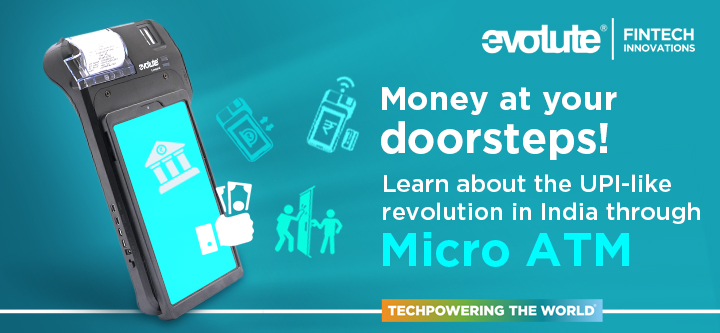India’s Unified Payment Interface (UPI) transactions clocked a new high in value in June by processing 13.89 billion transactions worth Rs 20.07 trillion, the highest in the world with more than 40% of the global share. Like the UPI, the financial landscape in India is undergoing yet another significant transformation with the advent of micro-ATMs, revolutionizing how people access banking services.
The distribution of ATMs within India is highly unbalanced, with metros having 53 ATMs per one lakh population, and rural areas having a meager nine ATMs per one lakh population. Over 65% of the Indian population resides in rural India, yet, they account for only 20% of all ATMs in the country.
The cost of infrastructure acquisition and servicing is one of the main reasons that formal financial institutions find it difficult to operate ATMs in rural areas. This is one of the main reasons why micro ATMs have been gaining traction steadily by filling the gaps created by traditional ATMs.
Similar to the impact of the Unified Payments Interface (UPI), micro-ATMs are making banking accessible to the unbanked and underbanked populations, ensuring financial inclusion in even the remotest parts of the country. Just like UPI, the micro-ATM is gaining popularity, purely because of its simplicity and high security.
What is a micro-ATM?
Micro-ATMs are portable, handheld devices that enable banking transactions outside traditional bank branches. These devices can perform functions such as cash withdrawals, deposits, balance inquiries, and fund transfers using just an Aadhaar card and a fingerprint, eliminating the need for debit or ATM cards. The simplicity and ease of use of micro-ATMs have made them a game-changer in delivering banking services at the doorstep, bank branches, or contact centers.
How Micro-ATMs Work
A user can access their bank account by simply providing their Aadhaar number and authenticating their identity with a fingerprint scan. This process is facilitated by the Aadhaar Enabled Payment System (AEPS), which leverages India’s biometric database. Once authenticated, users can carry out various banking transactions securely and conveniently.
Advantages of Micro-ATMs
1. Financial Inclusion
As of 2024, close to 80% of Indians hold a bank account, and are residing across 6 lakh villages and cities. Micro-ATMs play a crucial role in extending banking services, especially to rural and remote areas where traditional banking infrastructure is limited. Micro-ATM technology bridges the gap, ensuring that everyone has access to essential financial services, at their doorstep, without having to visit the bank branch. Women in rural India have been the major beneficiaries of micro-ATMs.
2. Employment and Skill Development Opportunities
The deployment of micro-ATMs has significantly boosted job opportunities & secondary income source to Village Level Entrepreneurs like, School teachers, Mobile SIM operator, Electronics Repair store, grocery stores & especially for women in self-help groups. These individuals, often referred to as banking correspondents, benefit by having micro-ATMs at their locations.
This initiative not only empowers them economically but also elevates their status in community development. By acquiring skills in digital literacy and banking operations, they become a crucial resource for the banking industry. This empowerment fosters economic independence and promotes inclusive growth, creating a more resilient and resourceful community.
3. Cost-Effective and Safe
Micro-ATMs are relatively low-cost devices, making them an affordable solution for financial institutions like banks, NBFCs, cooperative banks, and others to deploy. They also offer a secure way of conducting transactions, reducing the risks associated with carrying cash. The safety of micro-ATMs in India is getting further upgraded to Aadhaar L1 standards, which will further enhance the confidence of the masses to transact through it.
4. Convenience
Users can access banking services without the need for debit or ATM cards, reducing the hassle of carrying multiple cards and remembering PINs. The biometric authentication ensures secure and quick transactions.
Evolute Fintech’s Leopard® Micro-ATM: Leading the Charge
Evolute Fintech has introduced the Leopard®, a flagship product that epitomizes the benefits of micro-ATMs. The Leopard® is a high-performance, integrated tablet Micro-ATM with multiple features designed to facilitate seamless financial transactions.
- Biometric Scanners: Equipped with both fingerprint and optional IRIS scanners, the Leopard® ensures secure and reliable user authentication.
- Comprehensive Card Readers: Includes magnetic card readers and dual contact smart card readers, along with a contactless smart card reader for versatile payment options.
- Advanced Communication Capabilities: Supports GSM/GPRS, WiFi, and Bluetooth, enabling connectivity in diverse environments.
- Portable and Durable: Rugged design suitable for all conditions, with a long-lasting rechargeable battery ensuring continuous operation.
The Leopard® device enables banking correspondents and employees to perform on-the-move banking services, such as account opening, e-KYC, deposits, withdrawals, and fund transfers. It also supports RUPAY and other EMV card-based transactions when connected to an EMV-supported PIN pad.
Impact on e-Governance
Micro-ATMs like the Leopard® are not just limited to banking. They are integral to various e-governance initiatives in India, including:
- Public Distribution System (PDS): Ensuring efficient distribution of subsidized food and non-food items.
- eChallan: Facilitating the management of traffic fines and other legal penalties.
- Direct Benefit Transfers (DBT): Streamlining the transfer of subsidies directly to the beneficiaries.
- Portable and Durable: Rugged design suitable for all conditions, with a long-lasting rechargeable battery ensuring continuous operation.
The Leopard® device enables banking correspondents and employees to perform on-the-move banking services, such as account opening, e-KYC, deposits, withdrawals, and fund transfers. It also supports RUPAY and other EMV card-based transactions when connected to an EMV-supported PIN pad.
Conclusion
Micro-ATMs are indeed spearheading a financial revolution in India, akin to the transformative impact of UPI. By making banking services accessible, secure, and convenient, they are driving financial inclusion and empowering communities. Despite the successes of initiatives like the Pradhan Mantri Jan Dhan Yojana (PMJDY) and the JAM (Jan Dhan, Aadhaar, and Mobile) trinity, a significant portion of India’s population still lacks access to formal banking services. As of 2024, the government continues to strive towards complete financial inclusion, with innovative solutions like micro-ATMs playing a pivotal role.
Evolute Fintech’s Leopard® stands out as a prime example of how innovative technology can bring banking to the doorstep, ensuring that everyone, regardless of their location, has access to essential financial services. As India moves towards a more inclusive financial ecosystem, the role of micro-ATMs will only become more significant. For more information on Evolute Fintech’s Leopard® and how it can revolutionize your banking services, visit our website or contact our sales team today.





